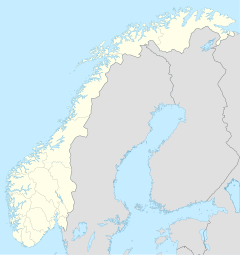|
West Air Sweden Flight 294
West Air Sweden Flight 294 was a cargo flight of a Bombardier CRJ200 from Oslo to Tromsø, Norway, that crashed on 8 January 2016. A malfunction in one of the inertial reference units had produced erroneous attitude indications on one of the instrument displays. The crew's subsequent response resulted in spatial disorientation, leading to the loss of control of the aircraft. Both crew members on board were killed.[1][2][3] Aircraft and crew The aircraft was built in 1993 as a CRJ-100 and was operated by Lufthansa CityLine as D‑ACLE until 2006. It had a manufacturer's serial number (MSN) of 7010 and had two General Electric CF34-3B1 engines.[4] The aircraft then underwent a cargo conversion, being re‑designated as a CRJ200-PF (Package Freighter) and was modified from CRJ-100 to -200 after the end of service with Lufthansa. The aircraft had been operated by West Air Sweden since 2007 as SE‑DUX.[5] At the time of the accident, it had accumulated more than 38,600 flight hours and 31,000 flight cycles.[6][7] The 42‑year‑old Spanish captain had around 3,200 flying hours, of which 2,016 were on this aircraft type; the 33‑year‑old French first officer had 3,050 flying hours, of which 900 were on this aircraft type.[3][8] FlightMap of Norway with location of the crash site, between the departure airport (Oslo) and intended destination (Tromsø). The aircraft departed Oslo-Gardermoen Airport at 23:11 hours local time for a flight to Tromsø Airport. The aircraft carried 4.5 tonnes (4,500 kg; 9,900 lb) of mail. The aircraft was in cruise at flight level 330 (nominal 33,000 feet [10,058 m]) before the aircraft transmitted a Mayday call at approximately 00:31, after which communications and radar contact with the flight were lost by air traffic control. Aircraft tracking service Flightradar24 reported that the aircraft fell 21,275 feet (6,485 m) over a period of 60 seconds, corresponding to a mean vertical speed of 355 ft/s (108 m/s) at 00:18, based upon data transmitted by the aircraft's transponder.[9] SearchBoth Norwegian and Swedish authorities searched for the aircraft, discovering the wreckage at 03:10 in the morning. The accident site was located at an elevation of 1,000 metres (3,300 ft) in a remote area near Lake Akkajaure, approximately 10 kilometres (6.2 mi; 5.4 nmi) from the Norwegian border. The aircraft remains were spread in a circle approximately 50 metres (160 ft) in diameter, which was said to suggest a high‑energy impact.[10]  Investigation  The Swedish Accident Investigation Authority (Swedish: Statens Haverikommission, or SHK) opened an investigation into the accident.[11] On 9 January 2016, the flight data recorder (FDR) was found severely damaged as well as parts of the Cockpit Voice Recorder (CVR). The CVR was, however, not intact, and the part containing the memory functions was missing. The following day, the missing parts of the CVR were found, alongside human remains.[12][13] On 12 January, SHK reported that the distress call from the pilots contained the word "Mayday" repeated, with no further information. On 26 January, Statens Haverikommission reported that they had managed to read both CVR and FDR, and were analysing and validating the recordings.[10] On 19 March, in their interim report, SHK revealed:
 Investigators discovered that, the inertial reference unit (IRU; which provides information to the flight crew's instruments) no. 1 (connected to the captain's instruments and the flight data recorder) had malfunctioned in-flight (the SHK was unable to determine the cause of the malfunction), causing the captain's artificial horizon to display a nose-up pitch, when in fact the aircraft was perfectly level.[15] The captain responded by pushing the yoke down in an attempt to regain level flight. Instead, the aircraft's nose lowered and it departed level flight. The aircraft then entered a steep dive traveling over 510 knots (940 km/h; 590 mph), nearly inverted, and banked over 40 degrees, causing the "bank angle" warning sounded in the cockpit. However, this alarm is connected to the inertial unit number 2, which provides information to the first officer's instruments. This indicated that the only the captain's instruments had failed and the first officer's were functioning properly, but neither pilots cross-checked their instruments. The first officer, despite having the correct attitude indication displayed, reacted insufficiently.[15] Unable to find a visual reference due as it was nighttime, the pilots became spatially disoriented and were further unable to manage the situation due to high G-loads.[3] The final report was published by SHK on 12 December 2016.[3] The inquiry reached the following conclusion:
The SHK issued 14 safety recommendations.[3] In popular cultureThe accident is featured in the second episode of Season 20 of Mayday, also known as Air Crash Investigation. The episode is titled "Impossible Pitch".[16] See alsoReferences
External links
|
||||||||||||||||||||||||||||||||||||

